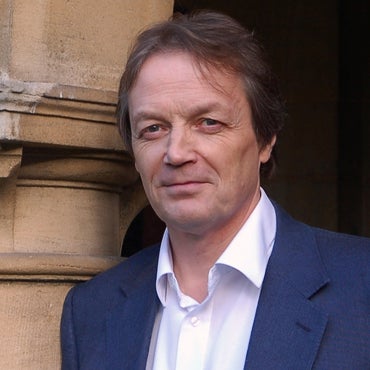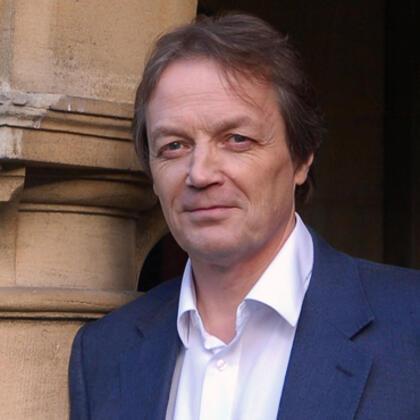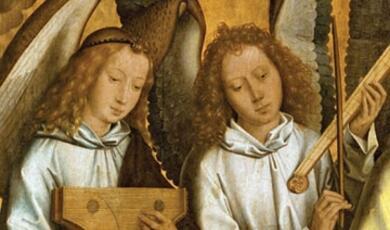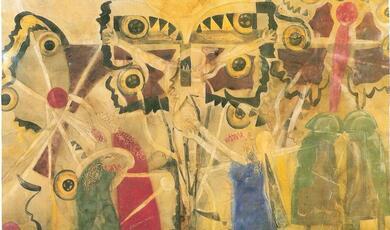The 'Romantic' Guitar
Share
- Details
- Transcript
- Audio
- Downloads
- Extra Reading
‘If I could play upon the guitar’, wrote John Keats in a letter, ‘I might make my fortune…’
This lecture will explore the beginnings of the guitar craze in Regency England around the time of Keats’ birth in 1795, as a form of salon amateurism; it will reveal the deep involvement of the instrument with some of the most potent themes of romanticism, especially in contemporary poetry of the high tradition (notably by Shelley) and the newspaper variety, together with serialised fiction. These themes include the night, the supernatural, and the complex allure of Spain and its guitars, celebrated by Byron in Childe Harold.
Download Transcript
9 October 2014
The ‘Romantic’ Guitar
Professor Christopher Page
Before I begin, I would like to introduce the musicians who will be performing this afternoon: the soprano Valeria Mignaco, and the guitarist, Jelma van Amersfoort.
Today, the guitar is probably the most popular musical instrument in existence. With millions of devotees worldwide, it eclipses the generally more expensive piano and allows a beginner to achieve passable results much sooner than the violin. You might be surprised to discover that the guitar has a long history in England. Queen Elizabeth received a set of three guitars on New Years’ day in 1559, as a gift. Almost exactly a century later, at the Restoration of the Monarchy in 1660, Charles II returned to England with his own guitar, carried home to London by the diarist Samuel Pepys, who complained of the trouble that it gave him. Queen Anne, who died in 1714 and gave her name to some of the most elegant architecture this country has ever known, also played the guitar, and her book of lessons still survives (although it has made its way to the other side of the Atlantic). The guitar may be a light instrument, in many senses of the word, but it is not at all ephemeral.
By citing those examples I do not mean to suggest that the guitar has always remained the same, or that its popularity has never waned. The guitar known to Elizabeth in 1559 was quite different to the one played by Queen Anne, and the guitars we play today are different again and immensely varied; but all the instruments concerned were recognizably guitars with a body resembling a figure eight, a circular sound-hole in the middle of the body and frets along the fingerboard. In one form or another, therefore, the guitar has proved indestructible, much to the chagrin of its critics, who have been legion. After all, to say that an instrument allows a beginner to achieve passable results quite quickly is to admit that its place in musical life can never be simple. The guitar has been the choice of gentlemen with positions in government but also of apprentices on low wages; of impoverished soldiers home from the wars, their guitar strap hitched over their fading uniforms, but also of society ladies. In most countries except Spain, it has generally been regarded as a foreign instrument: a potentially untrustworthy migrant worker on the musical scene. And yet it has survived. A distinguished French musicologist recently found, on the Internet, a performance of a late baroque masterpiece with a guitarist happily strumming away amidst the continuo group. He reacted with some anger. ‘Who is that clown playing the guitar?’ Yet think of some other plucked instruments that were played, like the guitar, in the time of Elizabeth: the lute, cittern, bandora, orpharion and the theorbo. They perished, and for many years they lay silent in their tombs, awaiting the general resurrection of the early music revival. The history of the guitar and its players in the early nineteenth century, like Shakespeare’s Twelfth Night, shows how a stage may empty leaving only the clown behind.
In my first year as Gresham Professor of Music, I am going to explore with you what this remarkable and long-lived instrument meant to people in a period of rapid social and technological change, perhaps the most dramatic that England has ever known. I mean the age of John Keats, Wordsworth, William Blake, Shelley, Byron and Coleridge. Those are the best-known poets of the so-called ‘romantic’ period, although they form a very diverse group and in recent years our sense of romantic writing has broadened to encompass a great many other authors of the period, many of them women. You may feel, as many do, that we should not use the term ‘romantic’ too often if we do not propose to say what it means. I shall turn to that eventually, but for the moment I simply wish to register that the lifetimes of the six canonical romantic poets, covering the period 1757 to 1834, enclose the period when the guitar in England rose from a position of relative neglect, to one of such fashionable eminence that it rivalled the pianoforte and harp as the chosen instrument of many amateur musicians.
We only have to look at London newspapers and magazines of the time to be convinced of that. I have selected a few from the year 1801, when you might suppose that few in England had much time for music. The struggle with Napoleon was very far from over in that year, and there was a shortage of food in some quarters as much of the fresh produce available was commandeered for the navy and soldiery. But in the comfortable West End of London, life went on much as before. On May 29, The Morning Post reported a concert organised in the house of the Countess of Aldborough; the tenor Giuseppe Viganoni sang a duet with and Lady Emma Hamilton; then ‘the beautiful Lady Emily Stratford played and sang several select pieces on the Spanish guitar, with much judgment and fine effect’. In July of the same year, an issue of The Lady’s Magazine offered its readers a print showing a woman seated with a five-string Spanish guitar. The heading says ‘Engraved for the Ladies Magazine July 1801’ and at the foot we read that the woman is wearing ‘Paris Dress’. Notice that the guitar has five, single strings; by this date, the instrument had relinquished the strings in pairs it had long shared with the lute, and at the time when this picture was published an extra was about to be added to make the six that any modern guitarist knows. Like many contemporary images of women with guitars, this one has a subtle but distinctly erotic quality: the flushed cheeks, the elegant neck, the plunging neckline and the bare arms. This is a woman firmly caught in the male gaze.
I would now like you to hear a piece by the French composer, Pauline Duchambge (d. 1858). Entitled Cancione amoroso, it is the kind of song that young men and women in England, but especially I suspect young women, obtained from abroad in cheap printed editions during the 1820s and 30s and learned to sing and play:
EXAMPLE 1 Cancione amoroso, Pauline Duchambge (d. 1859) approx. 3:33
The craze for the guitar, especially as an accompaniment to the voice, reached its peak in England about 1833-5. One way to trace that rise, and indeed to prove to you that it happened it, is to seek out the young women who offered their services as a governess and sought employment in private houses – the sisters of Jane Eyre, if you will. The graph on your handout shows the numbers of advertisements year by year, principally in the London press, placed by women seeking positions as schoolteachers, governesses or companions and including the Spanish guitar among the accomplishments they were prepared to teach. I have only included explicit references to the Spanish guitar, as opposed to ‘guitar’ alone, to be sure that our instrument is the one meant. I have also attempted to remove duplicates.
Numbers of advertisements, year by year, after 1800, principally in the London press (The Times,The Morning Post,The Morning Chronicle) showing women seeking positions as schoolteachers, governesses or companions and including the Spanish guitar among their accomplishments.
Why did this happen? Part of the answer lies with developments in the instrument. Around 1800 in England the guitar acquired a sixth a string added in the bass, giving it greater capacity at the bottom of its range. Although the instrument had long been considered ideal for accompanying the voice, it had never before been able to supply a true bass without compromise. Now it could do so. Indeed, many of the writers who criticized the guitar in our period, often very sharply, were in fact attempting to give it high praise when used in the proper way, by which they meant the as an accompaniment to the voice, and not as a solo medium for tedious sets of variations or over-ambitious sonatas.
For the next step, I turn to one of my predecessors as Gresham Professor of Music, Richard Stevens. I was recently browsing in his manuscript notes for a lecture he gave one day in May, in 1829. Evidently drawing on his own experience, Stevens records that the tenor Giuseppe Viganoni – the singer who performed duets with Emma Hamilton – was a rather listless musician on the operatic stage but in ‘private parties he used to accompany himself sometimes on the Spanish Guittar, when his fancy, taste and beautiful expression in singing were most uncommon and inexpressibly delightful’. I soon discovered that some other well-known singers of Italian opera in London from this period were guitarists, including Diomiro Tramezzani and Carlo Rovedino. I suspect that these Italians were much in demand for West-End gatherings soon after 1800, and that they showed what a fine accompanying instrument the guitar could be for a pleasing operatic air. Some of the earliest music printed for the guitar in England does indeed include arrangements of current Italian opera favourites.
We should also reckon with the continued growth of amateur musicianship, especially among women. The custom whereby a woman takes her husband’s name upon marriage, now regarded by many as a sign of servitude to be rejected, began in our period as a badge of freedom to be sought. It was a mark of respect, designed to distinguish women who had to work from those who did not, and who therefore had time to learn an instrument and to ensure that their daughters did the same. The teacher was often a governess, who of course did have to work for her living. To play before friends, or at some society gathering, even if only in one of the new provincial suburbs, was a sure sign of belonging to the leisured classes. Guitars were less demanding than pianofortes or harps and they were less expensive; a novice could buy one for less than a guinea by the 1830s, and they could be purchased more cheaply still at an auction.
My graph peaks in 1833, the year when guitarists acquired their first ever niche magazine in English, The Giulianiad. In one issue, the editorspose a question that seems especially appropriate to my subject today: the romantic guitar. ‘What instrument’, they ask, ‘so completely allows us to live, for a time, in a world of our own imagination?’ John Keats, in one of his letters, associates the guitar with popular novels and serialised romances that were beginning to our from the commercial presses of London and the provinces, and which were romantic in several very familiar senses of the word with their stories of desperate or triumphant love in an exotic setting. For Byron, a poet with a wider horizon than Keats, the guitar expressed the Spanish temper as the English commonly imagined it during the Napoleonic wars and long after: passionate and yet melancholic, lyrical and yet bellicose in the defence of political liberty. For Shelley in his Poem With a Guitar, the gentle sound of the instrument distilled the voices of Nature who had given the materials of her wooded hillsides to make it.
It was hard to write such poetry about the piano, for example, when one knew that it was a complex and costly piece of machinery made in a quasi-industrial manner. Like some other instruments with their moving and metal parts, the piano could all too easily be associated with the technical innovation and gadgetry which was so often a target of satire during the decades of the guitar’s ascendancy in the 1820s and 30s: steam-driven launches and coaches, street-lighting with gas, the metal objects associated with industrial centers such as Birmingham. What is more, much of the music composed for the piano was either vapid or, in some quarters, controversial. Here is a passage from an anonymous article published in 1820 and entitled ‘(The) Choice of Musical Instruments for Females’. (The term ‘females’ is often used in this way using our period, as if to evoke a species, as one might say ‘the choice of fodder for horses’). The writer is not at all convinced that the piano is the best choice for a young woman. He regards it as a difficult instrument: it has not half the beauty of more facile ones; and vocal music has such fascination, that even a trifling air with the guitar would, in ninety-nine instances out of a hundred, draw away the listeners collected round an exhibitor of Beethoven's crudities on (a) hundred-and-fifty guinea rose-wood, brass embossed, six octaved Grand Piano’.
One can hardly read that reference to ‘Beethoven’s crudities’ without raising both eyebrows, and keeping them there for some time, but notice how our author is contrasting those ‘crudities’ with the guitarand even the most ‘trifling air’ it might be summoned to accompany. Although he is surely no great admirer of the guitar and its repertoire, he is nonetheless making a claim for melody: its allure is both universal (everyone is drawn by it) and stronger than the seductions of genius, which may actually be repellant. This clearly has the potential to become wide-ranging and even political argument about the social value of music. A good air might seem trifling to those of stern judgment, and might even be disgusting to an elite defined by more sophisticated tastes, but it was unlikely to seem coarse or degenerate, as many in our period believed contemporary music to be. Nor could the accompaniment of a single guitar ever sound overcharged or befuddled with elaborate counterpoint – the faults that many discerned in music that was ‘ancient’, notably by Handel – because most guitarists were not capable of playing in such a manner. In short, the domain of the guitar was accompanied vocal melody and the power of song: the power of poetry set to lyrical melody that may engage the imagination of all
Before we go any further, I would like you to hear that combination of guitar and voice again, though the air is certainly not trifling.
EXAMPLE 2 La jeune fille Russe Pauline Duchambge
I suspect that the critic who deplored Beethoven’s ‘crudities’ for the piano, and who spoke up for the combination of voice and guitar, was responding a tunefulness that Beethoven cultivated on a more extended scale, with a more complex, and perhaps a more dissonant texture than anything he could accept. But the performance you have just heard suggests to me, as perhaps to you, that he was also reacting to sheer volume: to the amount of forte that was sometimes necessary to express the force of genius straining at the limits of what contemporary pianos and other instruments could provide. In 1818, the Heather Professor of Music at Oxford, William Crotch, observed that it was now the custom to adapt orchestral scores for the piano; he approved of the practice, but players were necessarily required to counterfeit the effect of an orchestral tutti, as best they could, which meant playing loudly, producing abrupt alternations between very loud and very soft which Crotch found distasteful. But everything was getting bigger and louder. ‘Hundred-and-fifty guinea rose-wood, brass embossed, six octaved Grand Pianofortes’ began to acquire cast-iron frames in the 1830s to support thicker strings of higher tension, making them more louder and more answerable to what composers and players were evidently trying to draw from their instruments. (It also, of course, made their manufacture more industrial). Violins were given new, more angled necks, higher bridges and higher tension strings, to make them louder and more penetrating. Several decades later, in 1843, Hector Berlioz (of all people) complained that pianists played with the dampers constantly lifted, ignoring the markings that composers like himself had been careful to insert; c’est le bruit, he wrote, c’est la confusion.
Berlioz, I am delighted to remind you, was a guitarist. Together with the flageolet, it was the only instrument he could play, and he was the only great composer of the nineteenth century who envisaged, albeit tentatively, how the guitar might be used as an orchestral instrument. He included a section on the guitar in his great treatise on instrumentation, first published in 1843, and what he has to say there is very arresting. He describes the sound of the guitar as ‘melancholic and dreamy: mélancolique et rêveur. This was also the view of some professionals; one of the greatest guitarists of the early nineteenth century, Dionysio Aguado, describes the instrument as armoniosabut also melancolica.The unique position of the guitar in the romantic period, I suggest, derived not only from its many practical advantages but also from the irreparable gentleness of its sound allied to a repertory that was largely vocal and therefore devoted to the performance of poetry. ‘The guitar’, wrote one critic in 1836, ‘is just calculated for the space of a sentry box; or the back room of a shopkeeper in the Burlington Arcade’. As another contemporary observer noted, this time an enthusiast, the guitar was ideal for performance in the domestic parlour where one could hear ‘the exquisite touches of a most delicate hand’.
As the technology of musical instruments made ever increasing use of moving parts and of metal, and as they were caught up in a flourishing culture of concert series, ticket sales, commercial sheet music and associated journalism, they became not only the means to express musical genius but also irretrievably mundane. Thus George Hogarth wrote in 1836:
It is a pity that, highly cultivated as music now is, so much of its romance should be lost. The most elaborate composition of Mozart or Beethoven will never awake, in the youthful heart, the feelings inspired by the graceful canzonets and roundelays sung by the accomplished cavaliers and fair ladies of the olden time, and accompanied on the Lute,—a word in which there is a thousand times more poetry than in the names of all the instruments in the Philharmonic Orchestra…When we connect romantic associations with the harp or the flute, do we think of the patent double-action of Erard, or the ten keys of the instrument played on by Nicholson?...As to the violin— king of instruments though it be—the very name is an antidote to every poetical or romantic idea.
Out author does not mention the guitar, but others were quite prepared to. In the Autumn of 1818 The Lancaster Gazette and General Advertiser published a short essay on musical instruments recommending the guitar to young men – to young men, notice – because it gives a very apt accompaniment to a ‘tolerable voice’; it is also ‘cheap…portable, and as rapturous and romantic as the most resolute enthusiast in sensibility and serenading can desire’. Some modern commentators are not content with the term ‘romantic’ guitar on the grounds that the music composed for the instrument shows little influence of what we might wish to call romantic musical idioms before the 1840s. I do not dispute that, I just think that it is too narrowly musical a view; our journalist from 1818 has no difficulty calling the guitar romantic and indeed rapturous.
So what does he mean by ‘romantic’ and what did George Hogarth mean by ‘every romantic idea’? The eighteenth century witnessed a massive effort, often in an antiquarian spirit, to recover the poetry and story of the Middle Ages and much more: the romances of king Arthur and other tales of chivalry, the legends of ancient Ireland and Scandinavia, the folk tales of Germany (think of the brothers Grimm) the ballads of the Scottish borders (think of The Hunting of the Cheviot). The term ‘romantic’ is of course related to ‘romance’, a term e inherit from the Middle Ages and which originally meant a narrative cast in what linguists still call a romance language, especially French. Much of this material was remote, fantastical and permeated by the supernatural to a depth that makes the idea of mere ‘magic’ (something you can pick up or put down, like Harry Potter) seem irrelevant. Here was a great wealth of prose but especially of poetry quite foreign to the Classical tradition of Greece and Rome with its values of balance, order and harmony embodied, for example, in the rhyming couplets of Alexander Pope or Samuel Johnson. When Hogarth refers to ‘every romantic idea’ he means, above all, what one might encounter in certain kinds of story: in contemporary novels with a medieval setting such as Ivanhoe; in serialized stories of love, with settings remote in time or place from the present, found in the new periodicals such as La Belle assemblée, or in prints such as the one you have on your handout, where a medieval minstrel plays the guitar to a group of court women in a forest scene. Imagine such a medieval scene transposed into the castle hall, and showing the minstrel seated at a piano. The absurdity of it says much about the distinctive ethos of the guitar and what it means to call that instrument the romantic guitar.
Throughout the period of the guitar’s ascendancy, and indeed beyond into the Victorian era when its popularity waned, serialized fiction in magazines such as La Belle Assemblée saturated the guitar with a romantic imagery of religious processions vesper bells and duennas nodding over their books of hours in Madrid or Salamanca. There is often a powerful undertone in this material of romantic melancholy touched by moonlight, solitude and even the omnipresent danger of a creeping madness:
The moon now shone full into the casement, and every sound being hushed, except the light trembling of the leaves that overshadowed the cottage, Laurette intimated a wish to retire, and was conducted by her hostess to her room. As she paused for a moment at the window of the apartment to enjoy the serenity of the scene, the notes of a guitar, accompanied by a female voice that breathed the most affecting sweetness, fixed her to the spot. The air, which was a melancholy one, seemed to have been awakened by no common sorrow…
This is a passage from Eleanor Sleath’s novel The Orphan of the Rhine (1798). Notice how it is touched with a certain menace. The scene is night: the most romantic hour of the twenty-four hour cycle: a time of serenity but also of danger; a time of rest but also of dream and nightmare. The moon is full – the moon of the lunatic in the strict sense – and it shines full into the room. The window is a casement: the kind of lattice that was generally replaced throughout London in the eighteenth century by sashes, so this is an old house, perhaps Elizabethan, and may conceal secrets as dark as the night. The leaves on the trees do not move in the wind, they ‘tremble’, and they ‘overshadow’ the house, even though it is night. The guitar accompanies a woman’s voice ‘that breathed the most affecting sweetness’, but the air is ‘a melancholy one, seemed to have been awakened by no common sorrow express ‘no common sorrow’. Our story goes even further than that, for we soon learn that the guitarist and singer in the story is a young woman who ‘had met with a disappointment in the tender passion, which had occasioned the loss of her senses’. So this is not just melancholy, it is madness. Lunacy even. This will reach its pathological extreme with the (male) guitar playing of Edgar Allen Poe’s The Fall of the House of Usher from 1839.
I have just spoken of that morbid condition of the auditory nerve which rendered all music intolerable to the sufferer, with the exception of certain effects of stringed instruments. It was, perhaps, the narrow limits to which he thus confined himself upon the guitar which gave birth, in great measure, to the fantastic character of the performances… They must have been…the result of that intense mental collectedness and concentration to which I have previously alluded as observable only in particular moments of the highest artificial excitement.
If Poe thought any other instrument better suited to the expression of his friends’ morbid, pathological temperament, he would surely have chosen it, but it seems that only the guitar will do.
You may think this wanders very far from the world of contemporary performance, but not so:
Oft, in the stilly night,
Ere slumber’s chain has bound me,
Fond memory brings the light
Of other days around me;
The smiles, the tears,
Of boyhood’s years,
The words of love then spoken;
The eyes that shone,
Now dimm’d and gone,
The cheerful hearts now broken!
Thus, in the stilly night,
Ere slumber’s chain hath bound me,
Sad memory brings the light
Of other days around me.
When I remember all
The friends, so link’d together,
I’ve seen around me fall,
Like leaves in wintry weather;
I feel like one
Who treads alone
Some banquet-hall deserted,
Whose lights are fled,
Whose garlands dead,
And all but he departed!
Thus, in the stilly night,
Ere slumber’s chain has bound me,
Sad memory brings the light
Of other days around me.
EXAMPLE 3 Oft in the stilly night Thomas Moore (1779-1852)
We come at last to the term ‘romantic’. I suggest that an important theme in most romantic art is what might be called the voluptuousness of death. To contemplate William Wordsworth, walking among the woods and daffodils of the Lake District, is to see a mean rapturously in love with flora and fauna that rose, ripened and rotted before his eyes in the span of a year. The Keats of Ode to a Nightingale is a poet ‘half in love with easeful death’, ready to drift away from the world of sense at the very moment when his senses are saturated with sweet odour and birdsong.
The last image on your handout comes from one of published albums and annuals of the later-Georgian years. The ‘embellishments’ published with these albums occasionally included prints and lithographs showing women with guitars, usually with accompanying poetry or prose, but only rarely were these idols of beauty still to be found among the living. The striking image of Katherine Airlie appeared with Fisher’s Drawing Room Scrap Book for 1841. It shows a woman who was treated with cruelty by a husband of ‘dissipated habits’ until she died of a broken heart. An accompanying poem leave no doubt about the painfulness of Katherine’s history, which consorts strangely (as it may now seem) with the glimpse of a woman in her private boudoir, lightly clothed, dressing her hair before bed, and with a guitar nearby to represent both the depth of her inner life and the consolations of music that she sought during her long-enforced loneliness ‘at a small house in Huntingdonshire’. (We are very close here to a familiar theme of contemporary Gothic novels: the preoccupation with ‘the persecuted heroine, who risks incarceration in the domestic sphere’). A rose has fallen from the bouquet on Katherine’s table as a discreet symbol of encroaching mortality. The accompanying verses run:
Oh, take that picture from the wall!
Dark shadow o’er my soul doth fall!
The past, the past returneth all!
Why didst thou die so early?
I dare not look upon thy face
Grief rends my heart like black disgrace;
I think upon the last embrace,
Ill-fated Katherine Airlie!
EXAMPLE 4 Je suis encore dans mon printemps Étienne Méhul (1763-1817)
HANDOUT ITEMS:
1 Parisian dress
2 Graph
3 Medieval scene
4 Airlie
© Professor Christopher Page, 2014
This event was on Thu, 09 Oct 2014
Support Gresham
Gresham College has offered an outstanding education to the public free of charge for over 400 years. Today, Gresham plays an important role in fostering a love of learning and a greater understanding of ourselves and the world around us. Your donation will help to widen our reach and to broaden our audience, allowing more people to benefit from a high-quality education from some of the brightest minds.


 Login
Login











